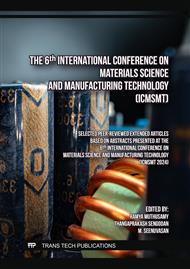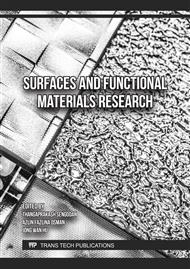[1]
I. Gurrappa, "Characterization of titanium alloy Ti-6Al-4V for chemical, marine and industrial applications," Mater Charact, vol. 51, no. 2–3, p.131–139, Oct. 2003.
DOI: 10.1016/j.matchar.2003.10.006
Google Scholar
[2]
A. U. Rajurkar, D. Thesiya, J. Dave, A. Rajurkar, and V. Prajapati, "Study on influence of EDM process parameters during machining of Ti-6Al-4V," 2016, [Online]. Available: https://www.researchgate.net/publication/303844227
Google Scholar
[3]
S. N. Patankar and M. J. Tan, "Influence of alpha casing on superplastic deformation of Ti-6Al-4V," J Eng Mater Technol, vol. 123, no. 1, p.144–147, 2001.
DOI: 10.1115/1.1325007
Google Scholar
[4]
T. S. Balasubramanian, M. Balakrishnan, V. Balasubramanian, and M. A. M. Manickam, "Influence of welding processes on microstructure, tensile and impact properties of Ti-6Al-4V alloy joints," Transactions of Nonferrous Metals Society of China (English Edition), vol. 21, no. 6, p.1253–1262, Jun. 2011.
DOI: 10.1016/S1003-6326(11)60850-9
Google Scholar
[5]
X. Yang, S. Li, and H. Qi, "Ti-6Al-4V welded joints via electron beam welding: Microstructure, fatigue properties, and fracture behavior," Materials Science and Engineering: A, vol. 597, p.225–231, Mar. 2014.
DOI: 10.1016/j.msea.2013.12.089
Google Scholar
[6]
Y. Fan, W. Tian, Y. Guo, Z. Sun, and J. Xu, "Relationships among the Microstructure, Mechanical Properties, and Fatigue Behavior in Thin Ti6Al4V," Advances in Materials Science and Engineering, vol. 2016, 2016.
DOI: 10.1155/2016/7278267
Google Scholar
[7]
M. Balasubramanian, V. Jayabalan, and V. Balasubramanian, "Prediction and optimization of pulsed current gas tungsten arc welding process parameters to obtain sound weld pool geometry in titanium alloy using lexicographic method," J Mater Eng Perform, vol. 18, no. 7, p.871–877, Oct. 2009.
DOI: 10.1007/s11665-008-9305-6
Google Scholar
[8]
N. K. Babu and S. G. S. Raman, "Influence of current pulsing on microstructure and mechanical properties of Ti-6Al-4V TIG weldments," Science and Technology of Welding and Joining, vol. 11, no. 4, p.442–447, Jul. 2006.
DOI: 10.1179/174329306X120750
Google Scholar
[9]
M. Heidarbeigy, F. Karimzadeh, and A. Saatchi, "Corrosion and galvanic coupling of heat treated Ti-6Al-4V alloy weldment," Mater Lett, vol. 62, no. 10–11, p.1575–1578, Apr. 2008.
DOI: 10.1016/j.matlet.2007.09.045
Google Scholar
[10]
F. Karimzadeh, M. Heidarbeigy, and A. Saatchi, "Effect of heat treatment on corrosion behavior of Ti-6Al-4V alloy weldments," J Mater Process Technol, vol. 206, no. 1–3, p.388–394, Sep. 2008.
DOI: 10.1016/j.jmatprotec.2007.12.065
Google Scholar
[11]
Y. Liu, S. Tang, G. Liu, Y. Sun, and J. Hu, "Effect of residual stress relaxation by means of local rapid induction heating on stress corrosion cracking behavior and electrochemical characterization of welded Ti-6Al-4V alloy under slow strain rate test," Metals and Materials International, vol. 23, no. 3, p.488–498, May 2017.
DOI: 10.1007/s12540-017-6628-6
Google Scholar
[12]
K. LI, X. song FU, G. qing CHEN, W. long ZHOU, and Z. qiang LI, "Mechanical properties of strengthened surface layer in Ti–6Al–4V alloy induced by wet peening treatment," Transactions of Nonferrous Metals Society of China (English Edition), vol. 26, no. 11, p.2868–2873, Nov. 2016.
DOI: 10.1016/S1003-6326(16)64415-1
Google Scholar
[13]
X. Luo, N. Dang, and X. Wang, "The effect of laser shock peening, shot peening and their combination on the microstructure and fatigue properties of Ti-6Al-4V titanium alloy," Int J Fatigue, vol. 153, Dec. 2021.
DOI: 10.1016/j.ijfatigue.2021.106465
Google Scholar
[14]
S. Kumar, K. Chattopadhyay, and V. Singh, "Effect of ultrasonic shot peening on LCF behavior of the Ti–6Al–4V alloy," J Alloys Compd, vol. 724, p.187–197, 2017.
DOI: 10.1016/j.jallcom.2017.07.014
Google Scholar
[15]
Conghui Zhang, Wei Song, Fengbo Li, Xu Zhao, Yaomian Wang, Guizhi Xiao "Microstructure and Corrosion Properties of Ti-6Al-4V alloy by Ultrasonic Shot Peening" Int. J. Electrochem. Sci., 10 (2015) 9167 - 9178.
DOI: 10.1016/s1452-3981(23)11168-0
Google Scholar
[16]
K. K. Liu and M. R. Hill, "The effects of laser peening and shot peening on fretting fatigue in Ti-6Al-4V coupons," Tribol Int, vol. 42, no. 9, p.1250–1262, Sep. 2009.
DOI: 10.1016/j.triboint.2009.04.005
Google Scholar
[17]
S. J. Lainé, K. M. Knowles, P. J. Doorbar, R. D. Cutts, and D. Rugg, "Microstructural characterisation of metallic shot peened and laser shock peened Ti–6Al–4V," Acta Mater, vol. 123, p.350–361, Jan. 2017.
DOI: 10.1016/j.actamat.2016.10.044
Google Scholar
[18]
P. Sanjurjo, C. Rodrguez, I. F. Pariente, F. J. Belzunce, and A. F. Canteli, "The influence of shot peening on the fatigue behaviour of duplex stainless steels," in Procedia Engineering, Apr. 2010, p.1539–1546.
DOI: 10.1016/j.proeng.2010.03.166
Google Scholar
[19]
H. sang Lee, D. soo Kim, J. sung Jung, Y. shik Pyoun, and K. Shin, "Influence of peening on the corrosion properties of AISI 304 stainless steel," Corros Sci, vol. 51, no. 12, p.2826–2830, Dec. 2009.
DOI: 10.1016/j.corsci.2009.08.008
Google Scholar
[20]
Q. Feng, J. She, X. Wu, C. Wang, and C. Jiang, "The Effect of Multiple Shot Peening on the Corrosion Behavior of Duplex Stainless Steel," J Mater Eng Perform, vol. 27, no. 3, p.1396–1403, Mar. 2018.
DOI: 10.1007/s11665-018-3204-2
Google Scholar
[21]
L. Xie, Y. Wen, L. Wang, C. Jiang, and V. Ji, "Characterization on Surface Properties of Ti-6Al-4V after Multiple Shot Peening Treatments," Journal of Engineering Materials and Technology, Transactions of the ASME, vol. 138, no. 4, Oct. 2016.
DOI: 10.1115/1.4033577
Google Scholar
[22]
T. H. De Keijser, J. I. Langford, E. J. Mittemeijer, and A. B. P. Vogels, "Use of the Voigt Function in a Single-Line Method for the Analysis of X-ray Diffraction Line Broadening," 1982.
DOI: 10.1107/s0021889882012035
Google Scholar
[23]
E. Avcu et al., "Corrosion Behavior of Shot-Peened Ti6Al4V Alloy Produced via Pressure-Assisted Sintering," Coatings, vol. 13, no. 12, Dec. 2023.
DOI: 10.3390/coatings13122036
Google Scholar
[24]
J. Johansson, M. Ode  N, and X.-H. Zeng, "EVOLUTION OF THE RESIDUAL STRESS STATE IN A DUPLEX STAINLESS STEEL DURING LOADING."
Google Scholar
[25]
H. Wang et al., "Effect of high energy shot-peening on the microstructure and mechanical properties of Al5052/Ti6Al4V lap joints," J Mater Process Technol, vol. 255, p.76–85, May 2018.
DOI: 10.1016/j.jmatprotec.2017.12.005
Google Scholar
[26]
C. Zhang, T. Fu, H. Chen, and Y. Gao, "Microstructure Evolution of Surface Gradient Nanocrystalline by Shot Peening of TA17 Titanium Alloy," Metall Mater Trans A Phys Metall Mater Sci, vol. 52, no. 5, p.1790–1798, May 2021.
DOI: 10.1007/s11661-021-06189-6
Google Scholar
[27]
M. Chen et al., "Evaluation of the residual stress and microstructure character in SAF 2507 duplex stainless steel after multiple shot peening process," Surf Coat Technol, vol. 344, p.132–140, Jun. 2018.
DOI: 10.1016/j.surfcoat.2018.03.012
Google Scholar
[28]
L. Zhu, Y. Guan, Y. Wang, Z. Xie, and J. Lin, "Influence of process parameters of ultrasonic shot peening on surface nanocrystallization and hardness of pure titanium," International Journal of Advanced Manufacturing Technology, vol. 89, no. 5–8, p.1451–1468, Mar. 2017.
DOI: 10.1007/s00170-016-9181-4
Google Scholar
[29]
S. Oh, D. Kim, K. Kim, D. I. Kim, W. Chung, and B. H. Shin, "The effect of surface roughness on re-passivation and pitting corrosion of super duplex stainless steel UNS S 32760," Int J Electrochem Sci, vol. 18, no. 12, 2023.
DOI: 10.1016/J.IJOES.2023.100351
Google Scholar
[30]
E. Arslan, Y. Totik, E. Demirci, and A. Alsaran, "Influence of surface roughness on corrosion and tribological behavior of CP-Ti after thermal oxidation treatment," J Mater Eng Perform, vol. 19, no. 3, p.428–433, Apr. 2010.
DOI: 10.1007/s11665-009-9504-9
Google Scholar



